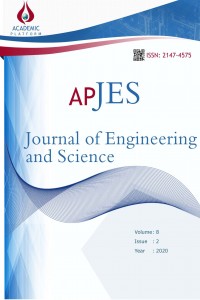Abstract
01 Ocak 2019’da yürürlüğe giren Türkiye Bina Deprem Yönetmeliği (TBDY-2018) ile yapılan değişikliklerin en önemlilerinden biri deprem yer hareketi spektrum hesabının, yapının bulunduğu konuma ve zemin değerlerine göre yapılacak olmasıdır. Bu çalışmanın amacı, spektrum eğrilerinin hesabındaki bu önemli değişikliğin, yapıya gelen kuvvet ve yapıda meydana gelen deplasman değerlerindeki değişime etkisini araştırmaktır. Çalışmanın ilk bölümünde, her iki yönetmeliğe göre (TBDY-2018 ve Türk Deprem Yönetmeliği 2007 (TDY-2007)), taban kesme kuvveti ve maksimum göreli kat ötelemelerinin hesap esasları ile ilgili genel bilgiler verilmiştir. Sayısal analizler için öncelikle 1996 tarihli deprem tehlike haritasında sırasıyla 1., 2., 3. ve 4. bölgede yer alan Sakarya-Serdivan, Kocaeli-Kandıra, Eskişehir-Sivrihisar ve Ankara-Yenimahalle konumları belirlenmiştir. Belirlenen her konumda 4 farklı zemin cinsi dikkate alınarak üç adet farklı kat sayılarına sahip (4, 7 ve 10 katlı) yapılar oluşturulmuştur. Tasarım depremi altında İDECAD programı yardımıyla, TBDY-2018 ve TDY-2007 yönetmelikleri hesap esaslarına göre, belirlenen yapıların analizleri gerçekleştirilmiştir. Analizler sonucunda elde edilen taban kesme kuvvetleri ve maksimum göreli kat ötelemeleri tablo ve grafiklerle sunulmuştur. Elde edilen sonuçlara göre taban kesme kuvvetinin, kat sayısı arttıkça eski yönetmeliğe kıyasla daha düşük değerler verdiği, maksimum etkin göreli kat ötelemelerinin her yükseklikteki binada özellikle zemin değerleri olumsuz şartlara doğru gittikçe eski yönetmeliğe nazaran çok daha büyük değerler verdiği görülmüştür.
Keywords
Taban Kesme Kuvveti Göreli kat ötelemesi TBDY-2018 Elastik tasarım spektral ivmesi TDY-2007
References
- [1]. Türkiye Deprem Bölgelerinde Yapılacak Binalar Hakkında Yönetmelik, (2018), Afet ve Acil Durum Yönetim Başkanlığı, Ankara.[2]. Öztürk, M., “2018 Türkiye Bina Deprem Yönetmeliği ve Türkiye Deprem Tehlike Haritası ile İlgili İç Anadolu Bölgesi Bazında Bir Değerlendirme”, Selçuk-Teknik Dergisi, 17(2),32-33. (2018).[3]. Tunç, G., ve Tanfener, T., “2007 ve 2016 Türkiye Bina Deprem Yönetmeliklerinin Örneklerle Mukayesesi”, 3.Ulusal Yapı Kongresi ve Sergisi Teknik Tasarım, Güvenlik ve Erişebilirlik, TMMOB Mimarlar Odası Ankara Şubesi, (2016).[4]. Erdem, M. M., Bikçe, M., “Maksimum Azaltılmış Göreli Kat Ötelemelerinin Güncel (DBYBHY-2007) ve Yeni Yönetmelik Taslağına (TBDY2018) Göre Mukayesesi”, Çukurova Üniversitesi Mühendislik Mimarlık Fakültesi Dergisi, 32 (2), 253-262, (2017).[5]. Elçi, H. ve Göker, K.A., “Deprem Yönetmeliklerinin (DBYBHY 2007 ve TBDY 2018) Betonarme Kolonların Deprem Performansı Açısından Karşılaştırılması”, International Journal of Scientific and Technological Research ISSN 2422-8702 (Online), 4(6), 9-21, (2018).[6]. Koçer, M. vd., “Deprem Kuvvetine Esas Spektral İvme Değerlerinin TBDY 2018 ve TDY 2007’ye Göre Karşılaştırılması”, Selçuk-Teknik Dergisi, 17(2),43-58, (2018).[7]. Türkiye Deprem Bölgeleri Haritası, Afet İşleri Genel Müdürlüğü Deprem Araştırma Dairesi, (1996).[8]. Deprem Bölgelerinde Yapılacak Binalar Hakkında Yönetmelik, (2007), Bayındırlık ve İskan Bakanlığı, Ankara.[9]. İdecad Statik, (2019), Yapısal Analiz Programı, Versiyon 10-0196 Statik.[10]. Türkiye Deprem Tehlike Haritası, Afet ve Acil Durum Yönetimi Başkanlığı, (AFAD, 2018).
The Effect of Spectrum Curves Defined by The Turkish Building Code 2018 on Multi-Storey Reinforced Concrete Buildings
Abstract
New Turkish Building Earthquake Code (TBDY-2018) has come into force on 01 January 2019 and one of the most important innovation brought by the regulation is the calculation of earthquake ground spectra, according to location of the building and its ground parameters. Purpose of this study is to investigate the effects of this important modification on the forces acting on the structure and the change in the displacement values occurring in the structure. In the first part of the study, according to both regulations (TDBY-2018 and Turkish Earthquke Code 2007 (TDY-2007)), principles of base shear force and the maximum relative storey drifts of buildings are given. For numerical analysis, Sakarya-Serdivan, Kocaeli-Kandıra, Eskişehir-Sivrihisar and Ankara-Yenimahalle locations were determined in the earthquake hazard map of 1996, respectively in the 1st, 2nd, 3rd and 4th earthquake regions. Considering 4 different soil types in each designated location, three different storey buildings (4, 7 and 10 floors) have been created. Analyses were performed according to TBDY-2018 and TDY-2007 for the design earthquake with the help of IDECAD structural analysis program. Thus obtained structure base shear forces and relative storey drift values presented with tables and graphs. According to the results, it was observed that the base shear forces gives lower values compared to the old building code as the number of storey increases, and the maximum relative storey drift gives much higher values than the old building code, especially when the soil types changes from hard to soft conditions.
References
- [1]. Türkiye Deprem Bölgelerinde Yapılacak Binalar Hakkında Yönetmelik, (2018), Afet ve Acil Durum Yönetim Başkanlığı, Ankara.[2]. Öztürk, M., “2018 Türkiye Bina Deprem Yönetmeliği ve Türkiye Deprem Tehlike Haritası ile İlgili İç Anadolu Bölgesi Bazında Bir Değerlendirme”, Selçuk-Teknik Dergisi, 17(2),32-33. (2018).[3]. Tunç, G., ve Tanfener, T., “2007 ve 2016 Türkiye Bina Deprem Yönetmeliklerinin Örneklerle Mukayesesi”, 3.Ulusal Yapı Kongresi ve Sergisi Teknik Tasarım, Güvenlik ve Erişebilirlik, TMMOB Mimarlar Odası Ankara Şubesi, (2016).[4]. Erdem, M. M., Bikçe, M., “Maksimum Azaltılmış Göreli Kat Ötelemelerinin Güncel (DBYBHY-2007) ve Yeni Yönetmelik Taslağına (TBDY2018) Göre Mukayesesi”, Çukurova Üniversitesi Mühendislik Mimarlık Fakültesi Dergisi, 32 (2), 253-262, (2017).[5]. Elçi, H. ve Göker, K.A., “Deprem Yönetmeliklerinin (DBYBHY 2007 ve TBDY 2018) Betonarme Kolonların Deprem Performansı Açısından Karşılaştırılması”, International Journal of Scientific and Technological Research ISSN 2422-8702 (Online), 4(6), 9-21, (2018).[6]. Koçer, M. vd., “Deprem Kuvvetine Esas Spektral İvme Değerlerinin TBDY 2018 ve TDY 2007’ye Göre Karşılaştırılması”, Selçuk-Teknik Dergisi, 17(2),43-58, (2018).[7]. Türkiye Deprem Bölgeleri Haritası, Afet İşleri Genel Müdürlüğü Deprem Araştırma Dairesi, (1996).[8]. Deprem Bölgelerinde Yapılacak Binalar Hakkında Yönetmelik, (2007), Bayındırlık ve İskan Bakanlığı, Ankara.[9]. İdecad Statik, (2019), Yapısal Analiz Programı, Versiyon 10-0196 Statik.[10]. Türkiye Deprem Tehlike Haritası, Afet ve Acil Durum Yönetimi Başkanlığı, (AFAD, 2018).
Details
| Primary Language | Turkish |
|---|---|
| Subjects | Engineering |
| Journal Section | Articles |
| Authors | |
| Publication Date | May 26, 2020 |
| Submission Date | November 1, 2019 |
| Published in Issue | Year 2020 Volume: 8 Issue: 2 |


